Bega Valley
Atmosphere & Weather | Biodiversity | Catchments | Resources Use
Bega Snapshots
These "snapshot" profiles celebrate recent environmental initiatives within this LGA.
1. It’s the Modern Sewer Age in the Bega Valley
2. On Site Sewage Management (OSM) Program
3. Coastal Environmental Weeds of the NSW Far South Coast
4. Bega Cheese Environmental Management System Project
5. An Estuary Management Plan for Pambula Lake
It’s the Modern Sewer Age in the Bega Valley
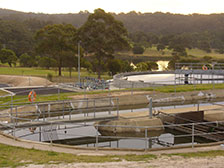
Bermagui STP Clarifier
The Bega Valley Sewerage Program expanded and upgraded sewerage facilities throughout the Shire. It was implemented between late 2003 and late 2008 at a cost of $72 million, half from the NSW Department of Water and Energy, half from Council. Environmental and health problems have been overcome and recycled water reuse opportunities created. Local businesses gained spin-offs through construction sub-contracts.
Five of the six existing Sewage Treatment Plants (STP) were markedly improved with effluent quality parameters vastly upgraded and disinfection added to most. Five villages - Candelo, Cobargo, Kalaru, Wallaga Lake and Wolumla - received sewerage services for the first time, with high technology plants eliminating a thousand septic systems. Plants are sized to meet future demands and tourist season loadings.
The new STP's use membrane bioreactor technology followed by ultraviolet disinfection and reuse of the reclaimed water via new automatic irrigation systems on nearby community facilities such as the Cobargo and Candelo showgrounds, Wolumla sportsground and the Kalaru racetrack and surrounds.
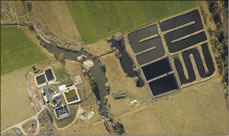
Bega STP after upgrade aerial
The new STP's use a pressure sewer collection system to transfer sewage with a small pump in every serviced property and polyethylene piping welded to ensure no joint leakage. Pressure piping doesn’t need to be laid to grade, significantly reducing the excavation required and disruption to properties and verges. It is quick to install and can be routed flexibly to avoid developed gardens, driveways and other difficult or special areas.
Five of the six existing STP's have had major upgrades to lift treatment levels and capacities. Technologies include aerobic sludge digestion, clarifiers, ultraviolet and chlorine disinfection, modern controls and improved storages. The higher quality reclaimed water is beneficially used nearby - on a Bega dairy property, Tathra’s golf course and sports fields, Bermagui and Merimbula golf courses and a Merimbula agricultural property, too. All in all, a job well done!
On Site Sewage Management (OSM) Program
Bega Valley Shire Council is the largest coastal local government authority in NSW. It has approximately 7000 systems of on site sewage management in the Shire with many of them adjacent to high quality lakes and rivers.
In 2001-02, the Council, in consultation with government agencies, the community and local professionals developed Council’s Development Control Plan for On-site Sewage Management (OSM) together with other Policy documents. In 2003 there was an estimated 4500 OSM’s in the Shire. With scarce resources a pragmatic approach was taken to the inspection and issue of approvals to operate these systems. This was based on a simplified risk management approach with systems either being low risk or high risk.
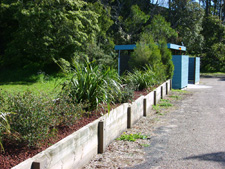
Mogareeka OSM upgrade
Being a coastal shire with 7 estuaries commercially producing very high quality shellfish, the high risk sites were the controlling aspect and were simply defined in the Plan. Village lots with an area of 2000 sq m with access to reticulated town water, OSM’s in the coastal zone, adjacent to waterways or dams, in areas with high water table(<2m below the surface) and in environmentally sensitive areas were all included in the definition. All other sites were defined as low risk sites.
The initial registration period through 2004-2005 identified over 6500 systems in the Shire. This was a much larger task than estimated. The registration process included considerable education activities particularly in regard the potential impact failing septic systems can have on the environment and public health. As a first step all Council operated sites (public facilities typically) were also defined “high risk” and were immediately inspected and upgrades required as necessary. The upgrades of all of Council’s operated OSM’s were completed over 5 years using environmental levy funds.
All other high risk sites were inspected as a priority. As expected a number of the high risk sites required upgrading but generally, however, landholders were aware of their systems shortcomings and were cooperative. Little enforcement action has been necessary.
Initially ‘high risk’ sites were issued with 2 year approvals to operate and the low risk sites were granted 5 year approvals. With Council policy direction being towards environmental health protection and with the much larger number of systems in the Shire than estimated this was quickly reviewed. High risk sites were issued 3 year approvals to operate to enable Council officers time for the re-inspection program. A system of inspections and approvals is managed within Council using a database, this includes a geographic information system to assist in the management of OSM’s in the Shire.
The catchment based assessment of high risk sites has meant that Council has been able to report on an estuary specific basis in regard the number of systems, types of systems, number of upgrades, number of failures etc. This information sharing has resulted in close liaison with the NSW Food Authority and the local Shellfish Programs and an openness in regard to Council’s approach to managing one of the threats to the very successful shellfish industry in the Shire.
Challenges and the next steps:
The Development Control Plan is now under review as part of the NSW government planning reforms. In addition Council is currently undertaking a very large sewerage provision program for 6 villages in the Shire. By 2009 this will see over 900 dwellings connected to the new sewerage schemes. Over the past 5 years the Shire has though experienced very steady growth and as such at the completion of this sewerage program there will still be an estimated 6500 OSM’s in the Shire.
Environmental health protection will remain the key aim and although Council’s direction will be towards fewer high risk sites the reality is that costs in implementing the program will continue to climb and that resources will become scarcer. Council’s direction in regard future management of OSM’s is going to remain risk based but is also likely to include fee exemption for voluntary augmentation or upgrades of systems. It is also likely that the risk categories will change with ‘Critical High Risk’ sites being introduced with 12 month approvals in an effort to better protect environmentally sensitive sites. Low risk sites will be granted 6 year approvals to operate and after the initial inspection by Council staff owners of these sites will likely to be able to “self-certify” their own system.
Funding will also be sought in an effort to address the growing problem of sewage discharges from vessels on the many lakes and rivers in the Shire. Difficulties in ensuring there are sufficient experts in on site sewage management in the Shire will continue to be a problem also. As one tradesman remarked, “Plumbers ain’t consultants for this stuff”.
Coastal Environmental Weeds of the NSW Far South Coast
This project was undertaken by the Far South Coast Weeds Strategy Team, a partnership between Bega Valley Shire Council, the Southern Rivers Catchment Management Authority (SRCMA), National Parks & Wildlife Division of the Department of Environment & Climate Change and the Far South Coast Landcare Association with funding from SRCMA.
The project mapped the distribution of environmental weeds along the coastal zone of the Bega Valley Shire. Data was obtained from surveys in winter and spring of 2007 and verified with data on weed distribution from previous surveys and reports.
The project report provides a general overview of the environmental weed issue along the coastal zone of the Shire followed by a more detailed discussion of the environmental weed problems in and around the four urban areas in that zone.
The Executive summary of the report concisely summarizes the situation. “Biological invasions now pose one of the most serious environmental threats to world ecosystems. Environmental weeds pose one of the gravest threats to native vegetation on the far south coast and to the amenity of coastal landscapes.
The great majority, about 80%, of coastal environmental weeds are escaped garden plants and are as yet confined to the periphery of the major settled zones. Accordingly, environmental weeds are very unevenly distributed across the landscape with few serious infestations occurring in the National Parks. Their massive impact in the longer settled areas of the coast demonstrates the magnitude of the potential long term threat to native vegetation.
Dumping of garden waste is unquestionably the most efficient way to establish environmental weeds among native vegetation. The practice is very widespread locally and unwittingly encouraged by Council waste disposal policies.
Government agencies have inadequate resources for environmental weed control and the problem is beyond the capacity of community volunteers. The far south coast, compared with much of SE Australia, is in an enviable situation in that many environmental weeds are at an early stage of invasion. They can still be controlled fairly cheaply and readily. Global warming and more intensive settlement are likely to accelerate weed invasion.”
The report also identifies important future steps are also identified in the report as are the priorities for environmental weed control across the major urban areas of the coastal zone.
“A profound change in attitudes, values, and behaviour is essential if we are to maintain healthy landscapes in the long term.
Finding ways to guarantee continuity of attention, effort, funding and responsibility is the great challenge posed by the environmental weed problem.
It is essential that all major environmental weeds have a legal status that requires landowners to remove them from their properties. The exercise of personal responsibility in gardening practices by gardeners working in proximity to natural vegetation , both in their choice of plants and the means of disposal of garden refuse , will greatly reduce the likelihood on new weed species and new infestations emerging.”
Funding issues have not yet been resolved. The report can be accessed on the Bega Valley Shire Council website: www.begavalley,nsw.gov.au /environment/weeds
Bega Cheese Environmental Management System Project
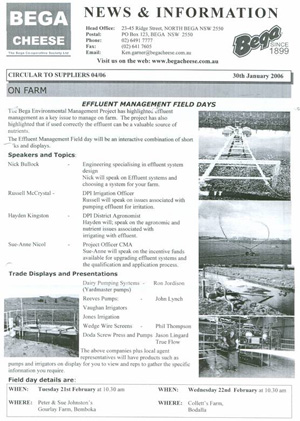
Bega Cheese News - Effluent Workshop
Bega Cheese and the Southern Rivers Catchment Management Authority (SRCMA), with technical assistance from the Bega Valley Shire Council and Department of Primary Industry, developed a pilot project for Bega Cheese dairy farmers to develop and implement an Environmental Management System (EMS) together with natural resource management (NRM) related works on-ground.
Funding was from the Natural Heritage Trust and the pilot project involving 20 dairy farms was a success. In 2006, the project was expanded and was subsequently made available to all interested dairy farms in the region.
The project is aimed at improving the environmental performance and natural resource management outcomes of the dairy industry. Key on farm projects have included dairy effluent management plans and upgrades, riparian fencing and alternative watering points, wetland protection, revegetation and alternative watering points,dairy laneway upgrades, stream crossing upgrades, farm soil nutrient mapping, whole farm plan development as well as training and field days.
One of the key factors for success of this project has been the partnership based approach. This has seen funds accessed for significant on-ground works. The project has developed a devolved grant process so that the Bega EMS Steering Committee, made up of the stakeholders and dairy farmers is able to approve funding of projects. This has involved the development of governance rules, funding guidelines, funding contracts and application forms. To date it is estimated that more than $10 million worth of works have been undertaken. The popularity of the project is shown by the contributions made by the farmers for works which currently leverage more than $3.40 for each grant dollar.
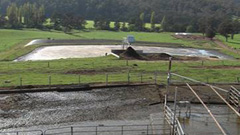
Dairy effluent system
Through this partnership project Bega Valley Shire Council has been able to partner and engage with the local dairy industry and catchment management authorities in providing technical assistance in the design and management of effluent management systems on farm with 32 effluent management systems having been upgraded to date. The project has meant that Council has been able to influence the environmental performance of the dairy industry in a very positive manner and without having to utilise other more onerous and less palatable regulatory controls.
Some of the key sustainability benefits from the project have included:
- Improved capacity to demonstrate responsible NRM to external stakeholders.
- Development of a clear and manageable path forward on how to meet NRM targets, particularly the River Health Agreement and in doing so helping to secure access to natural resources such as water.
- Development of critical partnerships with Southern Rivers CMA, Bega Valley Shire Council and NSW DPI.
- Improved access for the regions dairy farmers to government funds for on ground NRM works.
- Better understanding of the local dairy industries environmental foot print.
- Real progress towards improved management of the regions natural resources.
- Better business management through effective planning and systems which will ultimately make the whole regions dairy industry more sustainable into the future.
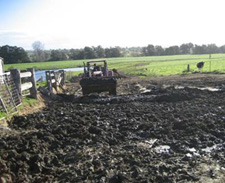
Dairy pad
The next phase of the project will likely see priorities change for funding and on farm works with increased emphasis on dairy laneway and stock crossing rehabilitation, revegetation, nutrient management (including feedpads), water use management and climate change adaptation and mitigation measures.
An Estuary Management Plan for Pambula Lake
In 2008 the Pambula Lake Estuary and Catchment Group (essentially an Estuary Management Committee under the NSW Estuary Management Program) was formed to prepare an Estuary Management Plan for Pambula Lake on the NSW Far South Coast.
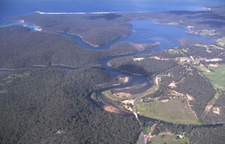
Aerial photograph of Pambula Lake
Guided by researchers from the Australian National University, the committee (which includes members from community groups, all levels of government, catchment management authorities and local landowners) is approaching the task by applying a ‘systems approach’ which embraces complexity, and provides a way to integrate disparate views. It thus helps the committee to address the whole range of relevant issues and gain perspective on how particular issues of concern relate to other estuary features and management decisions.
The Group is working to identify problems in the estuary and its catchment to create and implement a formal management plan that focuses on sustainability of the estuary. Issues include environmental health; protection of important coastal habitats, features and heritage items; the rehabilitation of degraded areas; improvement public access and amenity; and maintaining and improving water quality.
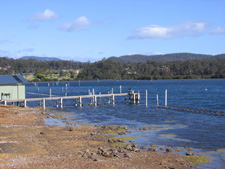
Oyster bed - Pambula Lake
The process began with the development of an influence diagram that summarised the estuary management committee’s view of the complex interactions that occur between the key variables of the full socio-biophysical system. This influence diagram represented the first step in the construction of a ‘situation display’ where a rich picture of the estuary management situation was built up. The information included in the situation display was then used to support an analysis of (a) the key variables that can be used to describe the state of the estuary, and (b) the processes, both natural and human-induced, that can alter the values of these variables. The analysis is aimed at identifying those features of estuary dynamics that need to be taken into account in the management plan. The analysis is being carried out by the participants in a Local Leaders Program sponsored by the Southern Rivers CMA.
Once the data compilation study has been completed, an Estuary Management Study and Plan will be produced.
